Cardinal tetras (Paracheirodon axelrodi) are vibrantly colored, lively little freshwater fish that make popular additions to a peaceful community tank.
This beautiful tetra species is often mistaken for the smaller Neon tetra, although they are not the same species. But are Cardinal tetras suitable for a beginner fish hobbyist, and what’s the best tank setup for Cardinal tetras?
Read this guide to learn everything you need to know about caring for the dazzling Cardinal tetra!
Cardinal Tetra – At A Glance
Scientific Name
Paracheirodon axelrodi
Common Name (species)
Cardinal tetra, Red Neon tetra
Family
Characidae
Origin
Parts of Venezuela and Brazil, Rio Negro, and the Orinoco River in South America
Diet
Omnivore
Activity
Active, schooling fish
Care Level
Medium
Lifespan
Annual in the wild, but 2 to 5 years in captivity
Temperament
Peaceful
Tank Level
Primarily the central part of the water column but frequents all areas of the tank
Minimum Tank Size
20 gallons
Temperature Range
Tropical 73° to 81° F
Water Hardness
2 – 8 dGH
pH Range
4.5 to 7.0
Filtration/Flow Rate
Prefers good filtration and a moderate to low flow rate
Water type
Freshwater fish
Breeding
Egg-layer. Challenging to breed in captivity
Compatibility
Peaceful community fish
OK, for Planted Tanks?
Yes
Origins
Cardinal tetras were first discovered by Schultz in 1965 and are distributed throughout Brazil and Venezuela and in South America, specifically, the Rio Negro and Orinoco Rivers.
Fortunately, these pretty fish are plentiful in the wild since most of the specimens seen in fish stores are wild-caught. That’s largely because it’s difficult to raise Cardinal tetras successfully in captivity, and catching them for the aquarium trade provides work for local people who would otherwise make money from deforestation.
The Cardinal’s appearance is heavily influenced by its origins. For example, gold and silver-blonde color forms are found in the Rio Negro drainage, whereas tetras that originate from the Orinoco possess a shorter blue stripe than fish caught in other areas.
Natural Habitat
Cardinal tetras are found living in large schools in slow-moving native river habitats. The rainforest canopy shades these shallow rivers, and leaf litter creates a blackwater habitat.
Appearance
It’s the Cardinal tetra’s vibrant colors and characteristic iridescence that make these little fish so popular with thousands of people around the world.
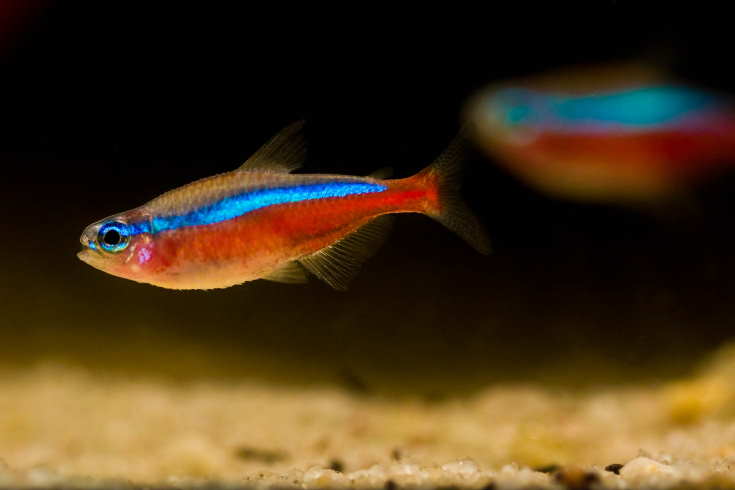
Cardinal tetras are deeply sapphire blue with a brilliant neon stripe extending for the full length of the fish’s body. Beneath the stripe is a broad bright red band.
Female fish are typically plumper and slightly bigger than males.
Cardinal Tetra Vs. Neon Tetra Size
Cardinal tetras and Neon tetras look very similar. However, Neons are smaller, typically measuring 1 to 1.25 inches long, whereas 1.5 to 2 inches is more typical for Cardinals.
Which Is Better – Neon or Cardinal Tetra?
Both Neon and Cardinal tetras are popular aquarium fish that make excellent additions to community tanks. Both are brightly colored, social fish with similar lifespans, and both are peaceful, although they can sometimes be a bit nippy.
Cardinal tetras are larger than Neons, and they tend to be hardier when it comes to disease resistance, although they are both sensitive to water conditions.
However, other than that, there’s not much to choose between the two species, so you might want to keep schools of both.
Lifespan
Cardinal tetras have a lifespan of roughly 2 to 5 years in captivity. However, the fish is an annual species in the wild.
Are Cardinal Tetras Aggressive Fish?
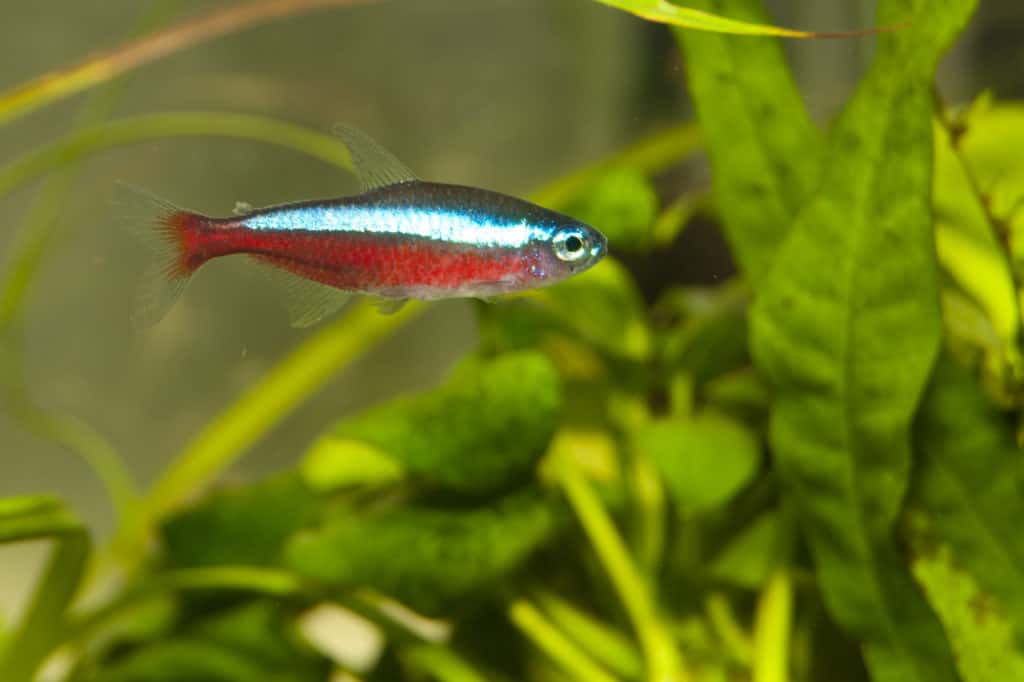
Cardinal tetras are lively, peaceful creatures that do best when kept in large schools to mimic their natural behavior.
Although not aggressive, Cardinal tetras do have a reputation as fin nippers. That said, I never found that to be the case when I had these fish in my community tank. Most cases of nippiness seem to happen when the fish are kept in small groups, so a large school seems to be the way to go.
Compatibility and Tankmates
How Many Cardinal Tetras Should Be Kept Together?
As previously mentioned, Cardinal tetras should be kept in large groups. Ideally, a school of a dozen or more fish is preferred, although you can get away with a group of six of these beautiful fish.
What Fish Are Best With Cardinal Tetras?
Cardinals typically get along well with other small peaceful fish, including danios, other types of tetras, Corydoras catfish, rasboras, Bolivian rams, and Dwarf gouramis.
Freshwater shrimp and snails are also suitable tank mates for tetras, and they make a useful cleanup crew, too.
Fish to Avoid
I recommend that you avoid including large, semi-aggressive fish species in a community tank with small tetras, as there’s a risk that your Cardinals will become a food source for the bigger fish.
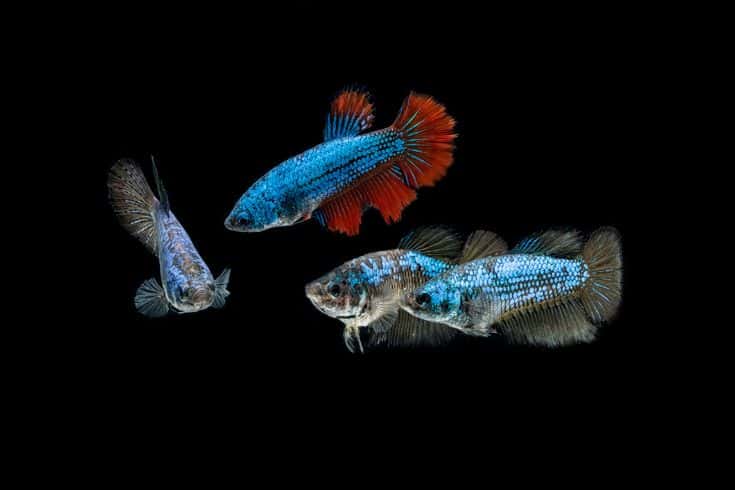
Fish with flowing finnage, such as bettas, are also best avoided, as Cardinal tetras can sometimes be rather nippy, and the stress that causes will make your betta sick.
Feeding
In the wild environment, Cardinal tetras enjoy a diet of plant matter, algae, tiny crustaceans, water fleas, insect eggs, and the like.
Cardinal tetras have pretty high vitamin requirements in their diet to remain healthy and show their best colors.
So, in captivity, you should feed your fish a high-quality, varied diet that includes high-quality flake food and frozen meaty protein sources, such as baby brine shrimp, daphnia, mosquito larvae, and bloodworms.
Can I Feed Cardinal Tetras Once A Day?
Ideally, you should feed your Cardinal tetras two or three times daily, giving the fish only what they will clear in a couple of minutes.
Tank Requirements
Tank size
If you want to keep a small group of Cardinals, I recommend a tank size of 20 gallons. However, a larger aquarium is a better choice for larger shoals of these active fish, as they need plenty of swimming space.
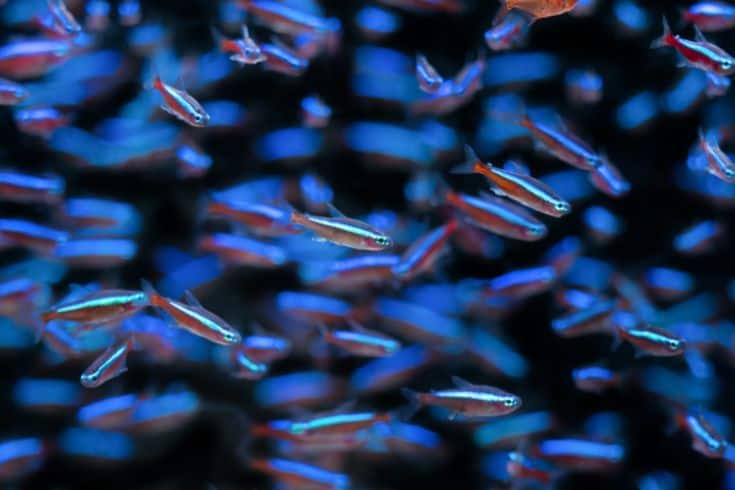
A long tank is better than a tall one, as that provides more surface area for efficient gaseous exchange, although Cardinal tetras will be quite happy in a tall aquarium, as they tend to swim in all areas of the tank.
These fish can jump! So, be sure to choose a tank with a cover slide or a tightly fitting lid to prevent accidents.
Tank Setup
Substrate
In the wild, Cardinal tetras inhabit a blackwater river environment with a sandy substrate. To replicate that in your aquarium, you should sprinkle some dried Indian Almond leaves onto the substrate to create the blackwater.
When it comes to a substrate, dark river sand is a natural-looking choice that shows off the tetras’ brilliant colors to the best effect.
Decoration
To help your fish feel at home, we recommend decorating your aquarium with natural elements, such as rocks, smooth stones, driftwood, and twisted roots. Be careful not to clutter the tank and leave plenty of space for schooling and swimming.

Plants
The Cardinal tetra’s wild habitat doesn’t contain many aquatic plants because the light is poor. However, I find that these fish enjoy some low-light, bushy plants in their tank, using them as hiding places and grazing on any algae or biofilm that grows on the leaves.
Floating underwater plants are a good choice, as they help to diffuse the light while adding a pleasing aesthetic to the tank.
Habitat Requirements
Cardinal tetras demand very clean, well-filtered water, and it’s recommended that you add these fish to a mature aquarium rather than a brand-new one.
Filtration
Cardinals need pristine water, so an efficient filtration system is essential for these fish to thrive.
In the fish’s natural habitat, the water is slow-moving, so we recommend an external canister or HOB filter to replicate that.
Water Parameters
Water Temperature
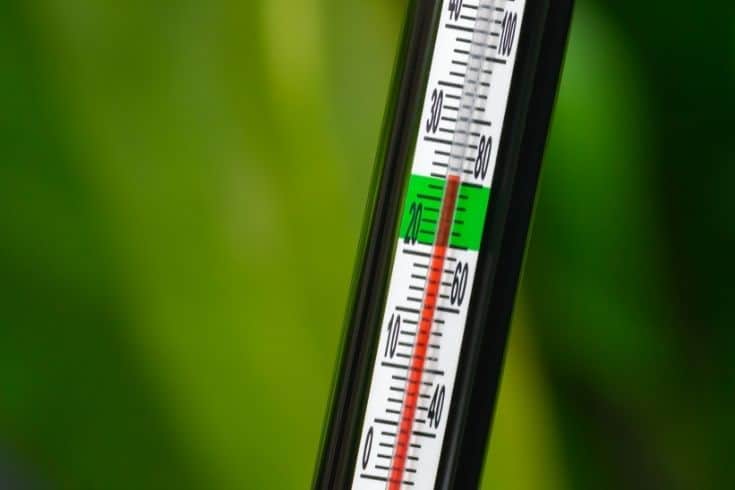
Cardinal tetras are tropical fish species that need warm water between 73° and 81° F to be happy.
Water Hardness and pH Range
The water pH should be in the range of 4.5 to 7.0, with a water hardness of 2 to 8 dGH.
Lighting
The water in which Cardinal tetras live is overshadowed by the rainforest canopy, making for pretty dim lighting conditions.
So, ideally, you want to use subdued rather than harsh lighting in your aquarium to replicate that.
Are Cardinal Tetras Hard To Keep?
Provided you carry out routine tank maintenance, Cardinal tetras are not difficult to keep happy.
Perform 25% to 50% water changes biweekly or 30% weekly if your aquarium is heavily stocked.
You should also vacuum the tank bottom to remove fish waste, uneaten food, and dead plant matter. That’s crucial to the water quality in your tank, as any organic waste matter will decay and pollute the water if you don’t remove it.
I recommend removing the filter media once every few weeks and rinsing it to remove sludge that could clog the impeller and prevent the unit from working properly. You’ll need to replace spent media periodically, as per the manufacturer’s instructions.
Use an algae scraper or magnet to remove algae from your viewing panes.
Setting Up the Aquarium
Start by assembling everything you’ll need to set up your new tank, including:
- Dark river sand
- LED lighting unit
- HOB filtration system
- Water conditioner
- Heater
- Aquarium thermometer
- Driftwood, twisted roots, smooth stones, rockwork
- Indian Almond leaves
- Low-light plants, floating plants
How to Set up Your Aquarium
- Wash the river sand under running water to remove dust.
- Place two or three inches of your substrate into the fish tank. I always put an upside-down bowl on the substrate and pour the water over it to prevent the substrate from being displaced.
- Plug in the filter units and heater but don’t turn them on.
- Add dechlorinated tap water to the tank just below the fill line.
- To get the nitrogen cycle underway, add a couple of drops of pure ammonia or a pinch of fish food to the tank. Do not add Cardinal tetras to a fish tank that hasn’t been fully cycled.
- Wash your decorations and arrange them in the tank as desired.
- If you’re including living plants in your setup, tidy up any broken stems or dead leaves before planting, and ensure you leave plenty of space between the plants for growth and spread.
- Switch on the filter and heater. You’ll also need to turn the tank lights on for eight to ten hours every day so that the plants can photosynthesize.
Generally, the nitrogen cycle takes around ten days to two months to complete. While you’re waiting, test the water each day. You want the levels of ammonia and nitrites to be zero, with nitrates being around 20 ppm for the water to be safe for your fish.

Keep testing the water daily until those levels are where they need to be, and you know it’s time to add your first few fish.
Health and Disease
Cardinal tetras are reasonably hardy fish, although poor water quality and adverse water conditions will kill them pretty quickly. So, as long as you maintain your tank correctly and provide the fish with clean water, they should remain healthy.
Signs of Good Health
Cardinal tetras should swim actively with their tank mates, spending much of their time exploring their habitat.
Red Flags
The following signs could be warnings of potential health issues brewing for your Cardinal tetras:
- Poor appetite
- Lethargy
- Not schooling with conspecifics
- Sores, bleeding, or ulcerated patches on the body
- Flicking or flashing against tank decorations or the substrate
Common Health Issues and Treatment
Health Issue
Ich (White Spot Disease)
Symptoms or Causes
Ich is a very common disease that’s caused by an aquatic protozoan parasite.
Fish infected with Ich develop a sprinkling of tiny white spots on their fins, gill covers, and bodies. They also flash against the gravel and other solid objects in the aquarium.
Suggested Action
Raise the water temperature to 82o F for three days. Use an OTC White Spot Disease medication to treat the tank.
Health Issue
Flukes
Symptoms or Causes
Flukes is the term used to describe various types of external fish parasites. These macroparasites can often be seen with the naked eye attached to the fish’s skin or gills.
Suggested Action
Treat the fish tank with an OTC antiparasitic medication.
Health Issue
Fungal infections
Symptoms or Causes
White fluffy growths on the fish’s body, mouth, and head.
Suggested Action
Quarantine infected fish, and treat with an antifungal medication.
Health Issue
Bacterial infections
Symptoms or Causes
Sores and ulcers on the body and head, ragged, bloody fins.
Suggested Action
Treat the tank with OTC antibacterial treatment.
Will Cardinal Tetras Breed In My Tank?
Cardinal tetras are egg-layers.
However, these fish are almost impossible to breed in captivity, so the ones you find for sale in pet stores are typically wild-caught specimens.
Availability
Cardinal tetras are readily available at most fish stores for a few dollars each or at discounted rates for larger groups. That’s the best way to buy these fish, as it’s not only cheaper, but the species does best in large groups.
Product Recommendations
- Water conditioner/dechlorinator
- Algae magnet
- Aquarium thermometer
- Aquarium vacuum
- Tropical fishkeeping books
- HOB or Canister filter, depending on aquarium size
- Aquarium (minimum size 20 gallons)
- Heater
- High-quality tropical fish flakes, frozen foods
- LED lighting unit
- Floating and low-light plants
- Smooth stones, driftwood, twisted roots
- Dark river sand substrate
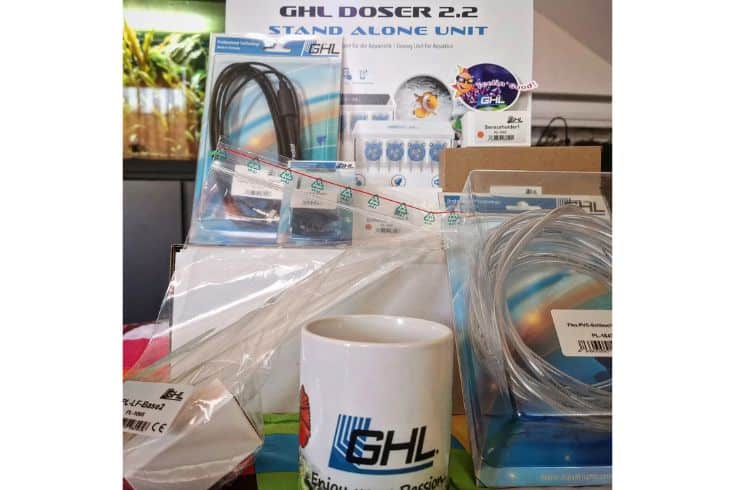
Final Thoughts
Did you enjoy our article on the dazzling Cardinal tetra? If you did, please take a moment to share the article!
Cardinal tetras are sometimes mistaken for Neon tetras, although the two fish are different species. Cardinals are relatively straightforward to care for and make wonderful additions to a community aquarium.
However, these fish require pristine water conditions to thrive, so we don’t recommend them for beginners.
Do you have Cardinal or Neon tetras in your tank, or perhaps you have both? Tell us in the comments box below!

I’ve got a lotto learn. I’ve got sand in my 20 gallon tank with plants, I got the tank already set up and had to replace the water ASAP . I plan on a Community tank with Molly’s, Plattsburgh, Guppies.Not sure howto treat water before adding fish. Also ,Fish didn’t look healthy today. Where is best place to buy healthy fish? Thanks
Hi Donna
Welcome to Tankarium!
It sounds like you need to check out our articles on the Nitrogen Cycle and How to Care For Freshwater Fish.
Your tank must be fully-cycled before you add any fish, otherwise, they will probably die. Before adding tap water to the tank, you need to treat it with a dechlorinator, and you can read all about that in this article.
The choice of fish that you want for your community tank sounds fine. Maybe add some corydoras catfish too. They’re super-cute, very hardy, and perfect for a beginner. You can buy healthy fish from most good small fish stores and online too.
Hope that helps! Enjoy your fish!
Alison Page
Site author